



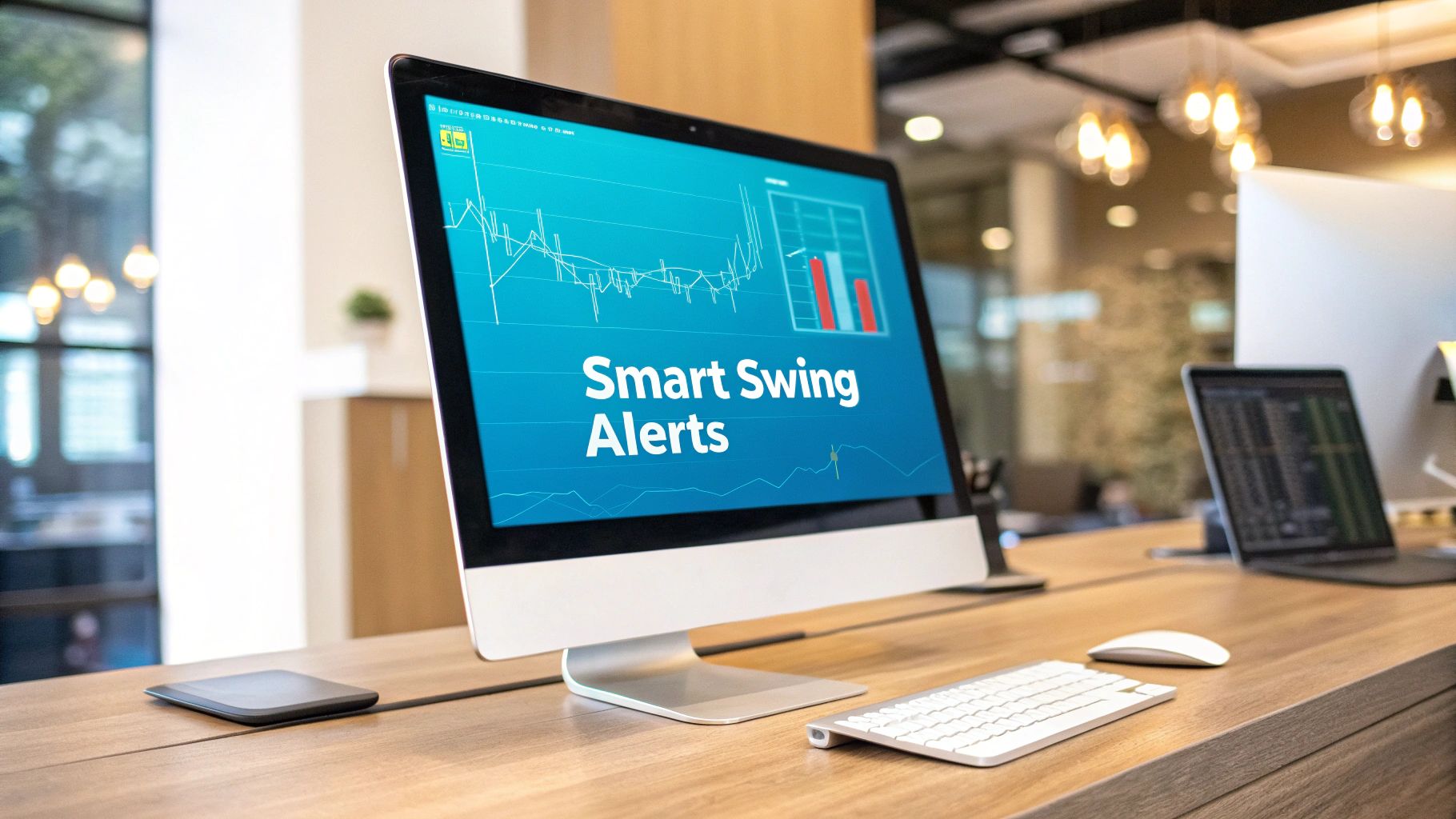
Imagine trying to fish in a vast ocean without a fish finder. You could spend all day casting your line randomly, hoping for a bite. That's what trading without a good alert system feels like. Swing trading alerts are your personal fish finder for the market, pinging you the moment a real opportunity swims by.
These aren't just random pings, though. They are automated notifications you set up based on your specific strategy. Whether you're watching for a price breakout, a specific chart pattern, or an indicator crossover, an alert does the tedious screen-watching for you. This frees you up to focus on the bigger picture instead of getting lost in the noise.
As a swing trader, your job is to catch medium-term "swings" in the market—trades that last from a few days to several weeks. But with thousands of stocks moving every second, how do you find the right wave to ride without getting exhausted?
This is where swing trading alerts are a game-changer. They act as your automated lookout, constantly scanning the market for the exact conditions you've defined. When a stock breaks through a key resistance level or flashes a bullish signal you're waiting for, you get an instant notification. No more missed opportunities because you stepped away for lunch.
Think of it this way: a swing trading alert turns your strategy into an action. It shifts you from being a reactive trader, swayed by emotion and market chatter, into a proactive one who executes a disciplined plan. You're no longer guessing where the next big move is; you have a system telling you exactly when it's time to act.
At their core, the best alerts are driven by pure, unbiased data. They rely on technical indicators and proven algorithms that filter out the market's emotional static. This systematic approach is your best defense against making impulsive trades based on fear of missing out (FOMO) or panic selling.
For example, a common strategy is to buy a stock after a significant dip. It's a simple concept, but when do you pull the trigger? Data gives you the answer. History shows that buying the S&P 500 after it dropped 5% from a recent high resulted in a median gain of around 6% over the next three months. Better yet, since 1980, this strategy has had an 84% probability of turning a profit.
That's the kind of edge data-driven alerts provide. You can learn more about these S&P 500 swing trading signals and see how they perform over time.
The image below gives you a clearer picture of what a successful alert system can achieve.
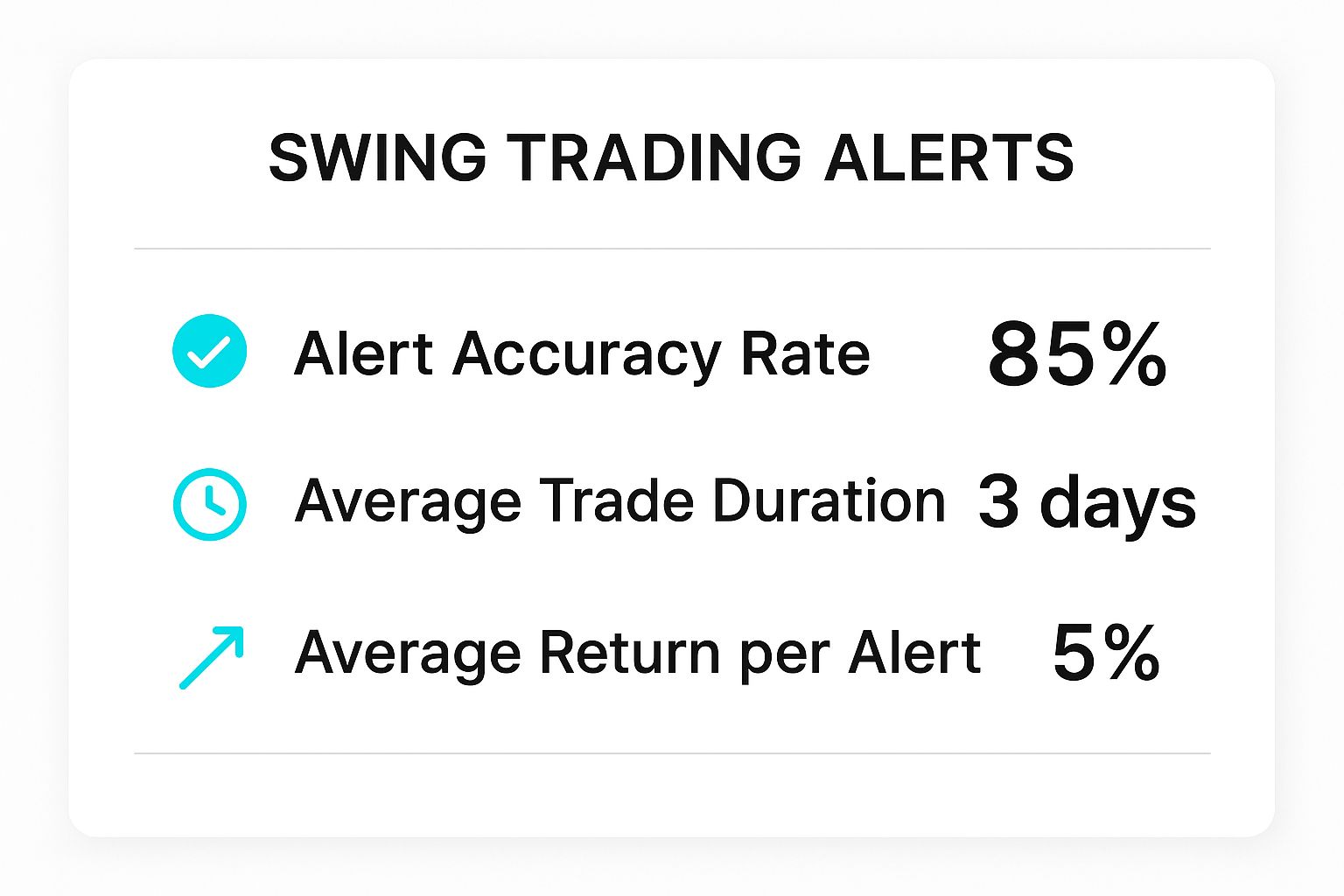
As you can see, a solid system isn't about hitting home runs every time. It's about delivering consistent, positive results with a high win rate over the long haul.
To give you a clearer idea, here is a quick summary of what swing trading alerts bring to the table.
Ultimately, using alerts helps you trade smarter, not harder, by bringing discipline and efficiency to your process.
Let’s break down the main advantages of weaving swing trading alerts into your daily routine:
Bringing alerts into your trading routine is more than just a small adjustment—it’s a complete upgrade to how you approach the markets. The right swing trading alerts give you real, measurable advantages that sharpen your edge, starting with the one thing you can never get back: your time.
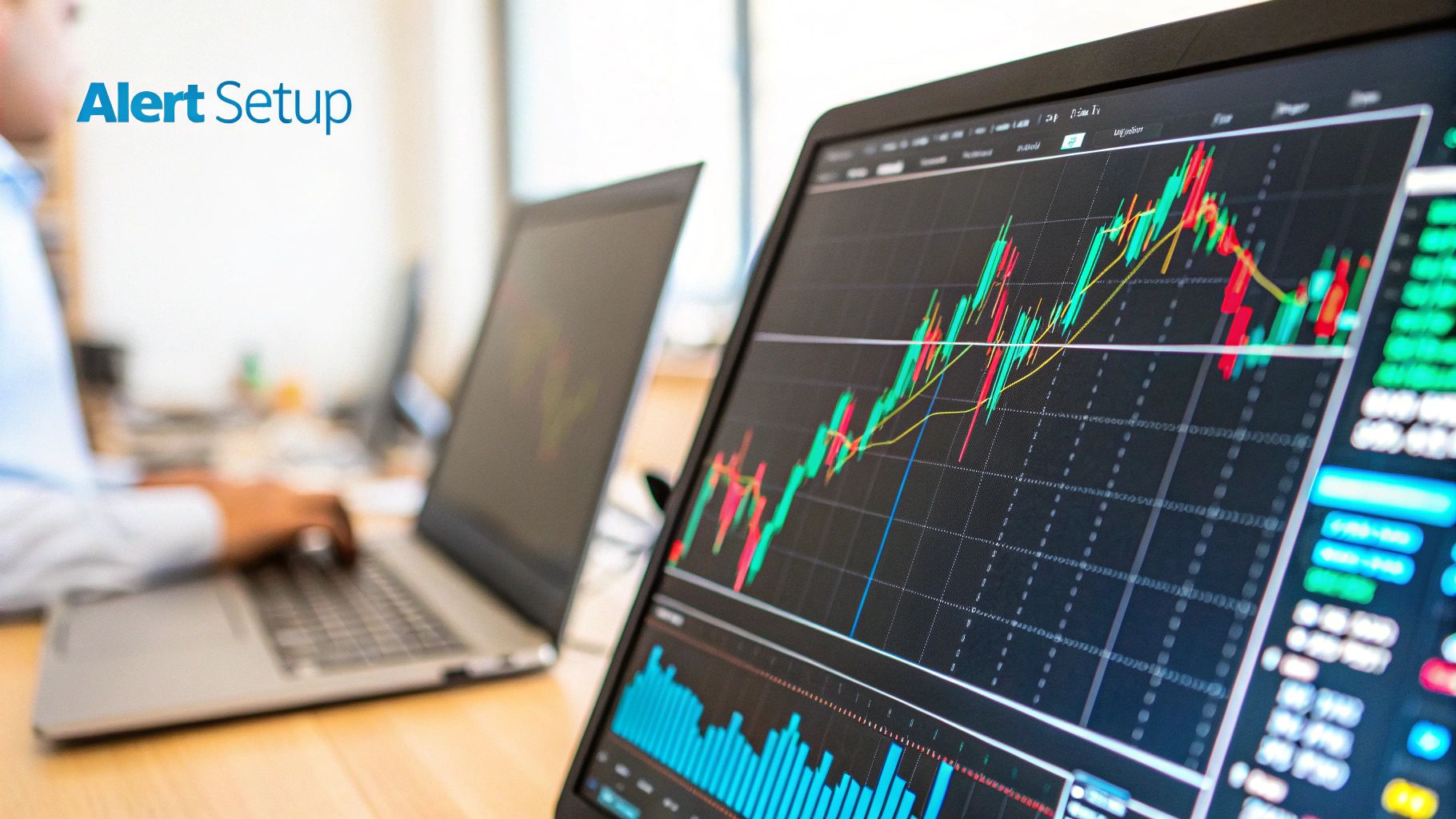
Think about it. Imagine trying to keep an eye on fifty different stocks, all waiting for that one perfect setup to appear. It's not just difficult; it's practically impossible to do well. You'd be chained to your screen for hours, a slave to the price ticker, terrified you'll blink and miss the one move that could define your week. Alerts flip this entire script.
By automating the "watching" part of trading, you get all those hours back. Instead of staring at charts, your mind is free to work on what really matters—refining your strategy, reviewing past trades, and managing your portfolio. The alert handles the grunt work, pinging you the moment your specific conditions pop up.
Let's be honest: one of the biggest hurdles for any trader is their own emotions. That rollercoaster of fear and greed can wreck even the most solid trading plan. A sudden price drop can trigger a panic sell, while a monster rally can ignite a bad case of FOMO (Fear of Missing Out), pushing you to chase a trade way too late.
An alert, based purely on data, acts as a circuit breaker for these emotional impulses. It's your objective, rational voice, based on rules you created when you were thinking clearly. It doesn't get swept up in market hype or scary headlines; it just follows the data.
When an alert goes off, it’s a simple reminder to execute the plan you already made. This creates a crucial gap between feeling an emotion and making a trade, helping you build the kind of discipline that separates consistently profitable traders from everyone else.
Good risk management is the foundation of surviving in the markets long-term. It's not about winning every single trade. It’s about making sure your losses are small and your wins are big enough to matter. Swing trading alerts are a huge help in building this discipline right into your workflow.
When you set up an alert, you aren't just looking for an entry signal. With powerful tools like EzAlgo, you can design alerts that automatically align with your personal risk rules. For example, you can create an alert that only fires when a stock not only enters your buy zone but also has a clear support level right below it to serve as your stop-loss.
This forces you to know three critical pieces of information before you ever click the "buy" button:
Following this system keeps you from jumping into trades without an exit strategy—a classic mistake that can lead to huge, unnecessary losses. By defining your risk upfront, you protect your capital and make sure no single trade can blow up your account. It turns trading from a gamble into a calculated business, one alert at a time.
To really get what makes modern swing trading alerts so effective, you have to look under the hood. The alerts many of us started with were pretty basic. They'd ping you when a stock’s price simply crossed a line you drew. It was better than nothing, sure, but it was like using a basic metal detector—it might beep, but it can’t tell you if you’ve found buried treasure or just an old bottle cap.
Today’s advanced alert systems are a different beast entirely. Think of them more like a sophisticated sonar grid mapping the ocean floor. They aren't just watching one price point; they're constantly analyzing a huge amount of data in real-time. The goal is to spot high-probability trading opportunities before they show up on everyone else's radar. This is a huge shift from simply reacting to price movements to actually anticipating them.
The real breakthrough came from integrating event-driven data. Instead of just asking, "Did Stock XYZ hit $50?" a modern alert system digs much deeper. It looks for the why behind a potential move, filtering for setups that have a real catalyst pushing them.
So, what kind of events are we talking about?
By scanning for these kinds of catalysts, modern alerts give you signals with a narrative. There's a reason why a stock is flagged as a potential mover. This gives you a massive leg up on traders who are just staring at lines on a chart. It’s the difference between seeing a wave and understanding the storm that’s causing it.
This is where the real magic happens. When you combine these events with artificial intelligence (AI) and rigorous backtesting, things get exciting. Advanced platforms use AI to scan thousands of stocks at once, hunting for these market-moving events with a speed and precision no human could ever hope to match. This isn't about finding generic chart patterns; it's about delivering signals backed by hard data.
For traders in the currency markets, this evolution should sound familiar. You can see a similar data-driven approach in our guide to understanding forex trading signals, where this kind of intelligence is just as critical.
For example, platforms like LevelFields use AI to analyze everything from earnings surprises to dividend changes and then immediately link those events to a specific swing trading strategy. The system knows what's worked in the past because it's been validated by extensive backtesting. This gives you a clear idea of how similar events have played out before you risk a single dollar.
This data-first approach transforms trading alerts from speculative guesses into powerful strategic tools. You're not just getting a "buy" signal; you're getting a full intelligence briefing on a potential trade.
This briefing is packed with key metrics that help you decide if the opportunity is right for you and your risk tolerance.
Key Metrics from Modern Alert Systems
By delivering this level of detail, modern swing trading alerts give you the power to make informed, confident decisions. They demystify the "why" behind every signal, allowing you to trade with a much clearer picture of the risks and rewards involved.
Theory is great, but there's no substitute for getting your hands dirty. Let's walk through setting up your first real swing trading alert on TradingView, one of the most popular charting platforms out there. We'll use a powerful indicator suite called EzAlgo to show you just how simple it is to turn a professional strategy into an automated notification.
The goal here is to pull back the curtain on the technical setup. By the time we're done, you'll have the confidence to create your own alerts that work for you 24/7, making sure you never miss a critical market move again.
Before you can create an alert, you need the engine that powers it—the indicator. For this walkthrough, we're using EzAlgo, which is well-known for its clean buy and sell signals. The very first thing to do is get it on your chart.
Once you have access, you'll find the EzAlgo indicators tucked away in your 'Invite-only scripts' section inside TradingView's indicator library.
Just like that, your chart will light up with signals, dynamic support and resistance levels, and other data points. This is the visual foundation we're about to build our automated alert on.
With the indicator loaded and active, you're ready to create the alert itself. Think of this step as giving TradingView a specific set of instructions: "Watch for this, and tell me when it happens."
An alert isn't just a notification; it's a command. You're essentially programming a trading assistant to follow a rule you've set, without emotion or hesitation. This is how you build discipline directly into your process.
To get started, find the "Alert" button in the top toolbar of your chart—it looks like a little alarm clock. Clicking it opens the "Create Alert" dialog box, which is where the magic happens.
This is your command center for the alert, where you'll define what triggers it and how you get notified.
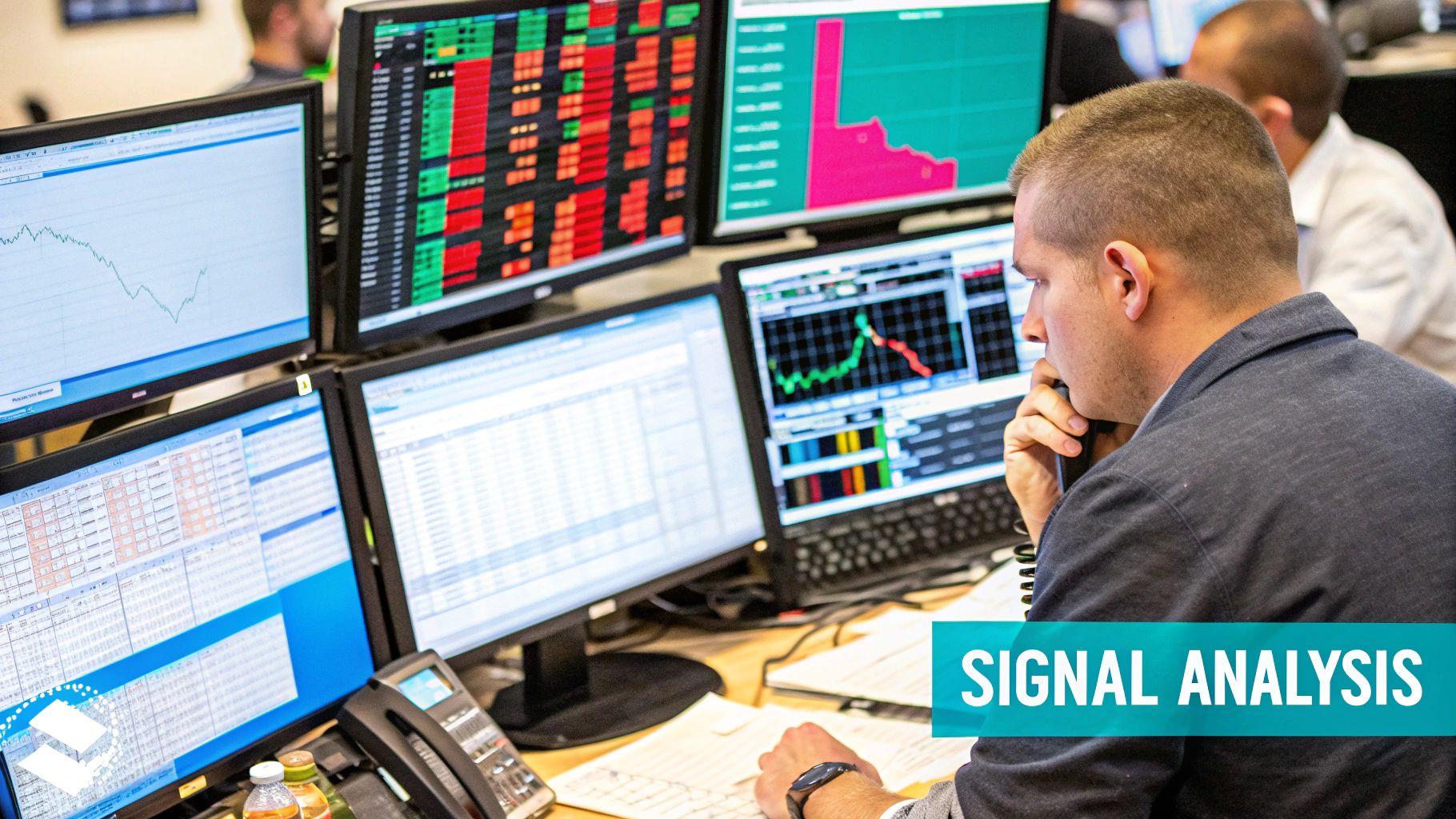
The screenshot above gives you a peek at the clean interface. You can see the fields for setting the condition, trigger frequency, and the message you'll receive.
This is where you tell your alert exactly what to do. The configuration screen has a few key sections, and getting them right is crucial. Let's break down what each one means.
ConditionThis is the core "if/then" logic of your alert. It tells TradingView the specific event that needs to happen for the alert to go off.
OptionsThis part controls the timing of your alert. It's more important than it looks!
Alert ActionsThis is the fun part—how do you want to be notified?
Alert Name and MessageFinally, give your alert a clear name like "AAPL Buy Signal - 4H Chart." In the message box, you can use handy placeholders to include dynamic info like the closing price. This is incredibly useful for seeing the exact trigger price without even opening the chart.
Once everything looks good, just click the "Create" button. That's it! Your first swing trading alert is now live, standing guard and watching the market for you.
Not all swing trading alert services are created equal. With so many options popping up, picking the right one can feel like a chore. The secret is finding a service that fits you—your trading style, how much risk you're comfortable with, and what you’re trying to achieve. Think of it as hiring a co-pilot for your trading journey; you need to trust their instruments and know they have a solid flight plan.
The single most important thing to look for is transparency. A trustworthy service won't hide its track record behind flashy promises. They should be proud to show you backtested data—real numbers like win rates, average profit per trade, and how long they typically hold a position. Without that proof, you're not buying a professional tool; you're just buying a lottery ticket.
Before you pull out your credit card, you need to understand how a service generates its alerts. Are they looking at technical signals, like chart patterns or indicator crossovers? Or are they reacting to news events, like an earnings beat or a big company announcement? Neither approach is "better," but one will almost certainly feel more natural for the way you like to trade.
Pay close attention to the detail that comes with each alert. A great service gives you more than just a stock ticker and a "buy now!" message. You should be looking for alerts that include:
This level of detail helps you make smart, calculated decisions instead of just following signals blindly. You can learn more about these different methods in our guide to swing trading strategies for beginners.
Finally, let's talk about price. It's always tempting to grab the cheapest deal, but you have to measure that cost against the quality of what you're actually getting. A service that costs $100 a month but consistently hands you profitable trade ideas is a much better deal than a $20 service that sends out weak, unreliable signals.
The good news is that these services have gotten much more sophisticated. For example, some platforms use heavy data analysis to find historically profitable setups. One service, Stock Market Guides, claims an impressive average annual return of 79.4% on its stock picks, with plans starting around $49 a month. As detailed in this breakdown of top swing trading alerts, their entire model is built on sifting through historical data to find statistical edges, then sending members clear alerts with entry and exit points. This shows how far things have come from simple hot tips to truly data-driven strategies.
Ultimately, the right alert service is a powerful tool to supplement your own research, not replace it. It should save you hours of scanning charts, surface high-quality trade ideas, and give you the data you need to trade with confidence.
Getting a great swing trading alert is exciting, but it's only the first step. What you do next is what separates successful traders from everyone else.
Think of an alert like a skilled scout reporting back from the front lines. The scout gives you crucial intelligence, but you're the general who has to make the final strategic call. This mindset is everything. Alerts are fantastic tools for spotting opportunities and staying disciplined, but they aren't a crystal ball. They support your judgment; they don't replace it. Getting this right from the start will protect your capital and your confidence.
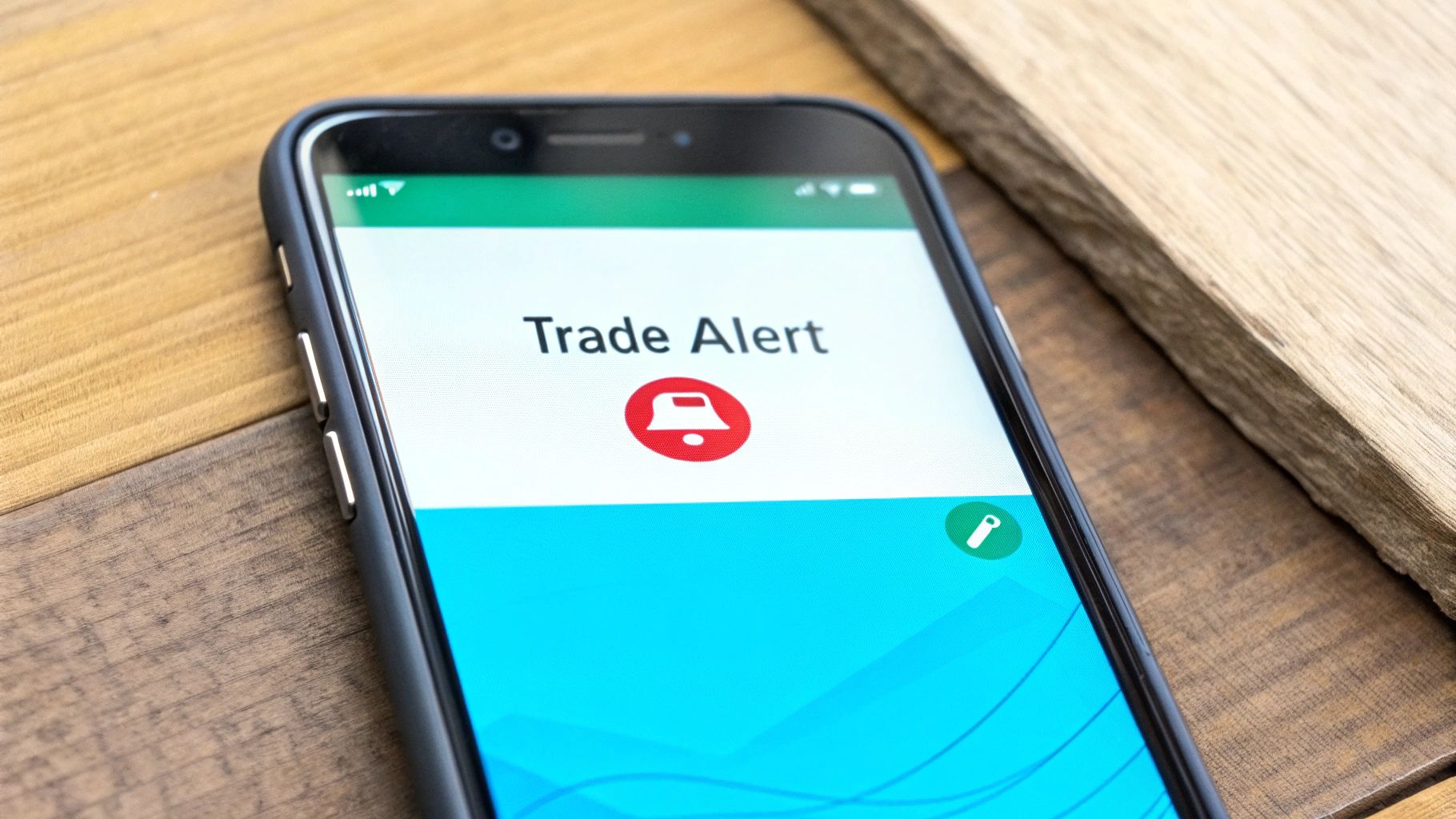
When an alert goes off, it's a call to action—not a blind command to buy or sell. The first thing you should always do is pull up the chart and check the setup against your own trading plan. Does the market structure look solid? Is the risk-to-reward ratio something you're comfortable with? The alert brought the opportunity to your door, but you have to give it the final green light.
Never, ever follow an alert service blindly, no matter how good its reputation is. Make sure it aligns with your strategy. This simple step keeps you in the driver's seat and ensures you own every decision, win or lose.
Your trading plan is your personal rulebook. It defines exactly how you enter trades, where you take profits, how much you risk, and when you cut a loss. An alert has to fit within that plan, not blow it up. If a signal points to a trade that breaks one of your core rules, you need the discipline to just let it go.
Sticking to your plan is what builds consistency. It stops you from chasing random tips and makes sure every trade is a deliberate step toward your bigger goals. An alert is a suggestion; your plan is the law.
This disciplined approach is what trading for a living is built on. It keeps your decision-making consistent, which ultimately makes your results more predictable over the long run.
This is the golden rule of trading, and it's non-negotiable for every alert you act on. Before you even think about hitting the "buy" button, you must know your invalidation point—the price where your trade idea is officially wrong. That’s where your stop-loss goes.
Your position size should be calculated from that stop-loss, making sure a losing trade only costs you a small, predetermined slice of your account (usually 1-2%). This simple habit ensures that no single trade can knock you out of the game, allowing you to survive the inevitable losses and live to trade another day.
It’s easy to get carried away and set up dozens of alerts, hoping you won’t miss a single move. But this almost always backfires, leading to "alert fatigue"—a state where you're so overwhelmed by noise that you can't think clearly. When you're bombarded with signals, you start making impulsive, sloppy trades.
The key is to focus on quality, not quantity.
By focusing only on the most relevant signals, you stay sharp and can put your full energy into analyzing the setups that actually matter.
As you get into swing trading alerts, a few key questions always pop up. It's smart to tackle these head-on. Getting clear answers is the best way to feel confident and use these tools the right way. Let's walk through some of the most common ones.
Absolutely not. Think of a swing trading alert as a valuable tip from a trusted colleague, not an order from your boss. These alerts are fantastic for flagging potential trades and saving you from staring at charts all day, but they aren’t a replacement for your own brain.
A smart trader always takes that alert and runs it through their own checklist. Does this trade fit my personal strategy? Does the potential reward justify the risk I'm taking? The pros use alerts to start their research, not to end it. That's how you build consistency over the long haul.
You'll find prices all over the map, but as with most things, you get what you pay for. Free services are usually free for a reason—they often lack the reliable data and clear trade plans you need to trade seriously.
Generally, you can expect a few different levels of service:
It's not about finding the cheapest option; it's about finding the best value. A $100/month service that consistently hands you well-researched trade ideas is a much better deal than a $20/month one that just creates noise.
Yes, but with one major string attached: you have to use them to learn, not just to copy. For someone new to trading, a good alert service can be like looking over the shoulder of a seasoned pro. You get a front-row seat to see how real strategies work in a live market.
You’ll start to see what a good setup looks like, understand the logic behind entry and exit points, and watch how risk is managed on every single trade. This can shave months or even years off your learning curve. The catch is that you have to pair it with your own education, especially when it comes to managing your risk.
Ready to stop guessing and start trading with data-driven precision? EzAlgo provides the AI-powered signals and institutional-grade tools you need to find high-probability setups and manage your trades with confidence.